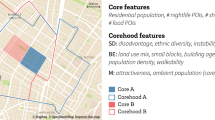Abstract
Predictive mapping of crime and anti-social behaviour is becoming more and more popular as a tool to support police and policy makers. Important ingredients of such models are often demographic and economic characteristics of the area. Since those are hard to influence, we propose to use the environment instead. In this paper, we present a model based on environmental criminology theories that is purely based on the buildings and objects in the neighborhood, such as bars, restaurants and parks. We show the strength and predictive power of this approach on the area of The Hague and Delft and present how the results can be interpreted by policy makers.






Similar content being viewed by others
References
Akman, E., & Cubukcu, E. (2012). The influence of micro scale environmental characteristics on crime and fear. Procedia - Social and Behavioral Sciences, 35, 83–88.
Beirne, P. (1993). Inventing criminology. Essays on the rise of homo criminalis. New York: State University of New York Press.
Bernasco, W., & Block, R. (2011). Robberies in Chicago: A block-level analysis of the influence of crime generators, crime attractors, and offender anchor points. Journal of Research in Crime and Delinquency, 48(1), 33–57.
Brantingham, P., & Brantingham, P. (1981). Environmental criminology. Beverly Hills: Sage.
Brantingham, P., & Brantingham, P. (1995). Criminality of place. European Journal on Criminal Policy and Research, 3(3), 5–26.
Caplan, J. M. (2011). Mapping the spatial influence of crime correlates: A comparison of operationalization schemes and implications for crime analysis and criminal justice practice. Cityscape, 57–83
Caplan, J. M., Kennedy, L. W., & Miller, J. (2011). Risk terrain modeling: Brokering criminological theory and GIS methods for crime forecasting. Justice Quarterly, 28(2), 360–381.
Caplan, J. M., Kennedy, L. W., & Piza, E. L. (2013). Joint utility of event-dependent and environmental crime analysis techniques for violent crime forecasting. Crime and Delinquency, 59(2), 243–270.
Clarke, R. V. (1992). Introduction. In R. V. Clarke (Ed.), Situational crime prevention: Successful case studies. Albany: Harrow and Heston.
Cohen, L., & Felson, M. (1979). Social change and crime rate trends: A routine activity approach. American Sociological Review, 44(4), 588–608.
Eiben, A. (2003). Introduction to evolutionary computing. New York: Springer.
Felson, M. (1994). Crime and everyday life: Insight and implications for society. Thousand Oaks: Pine Forge Press.
Hägerstrand, T. (1957). Migration and area: survey of a sample of Swedish migration fields and hypothetical considerations on their genesis. In: D Hannenberg, T. Hägerstrand and B. Odeving (Ed.), Migration in Sweden: A symposium (pp. 27–158). Lund Studies in Geography, Series B.
Hansen, N. A. (2001). Completely derandomized self-adaptation in evolution strategies. Evolutionary Computation, 9(2), 159–195.
Land, K., & McCall, P. (2001). The indeterminacy of forecasts of crime rates and juvenile offenses. In J. McCord, C. Widom, & N. Crowell (Eds.), Juvenile crime, juvenile justice. Washington: National Academy.
Lochner, L. (2004). Education, work, and crime: A human capital approach. International Economic Review, 45(3), 811–843.
Mehryar Mohri, A. R. (2012). Foundations of machine learning. Cambridge: The MIT Press.
Painter, K. (1996). The influence of street lighting improvements on crime, fear and pedestrian street use, after dark. Landscape and Urban Planning, 35(2–3), 193–201.
Ratcliffe, J. H., & Rengert, G. F. (2008). Near-repeat patterns in Philadelphia shootings. Security Journal, 21(1), 58–76.
Rojas, R. (1996). Neural networks—A systematic introduction. Berlin: Springer.
Rossmo, D. K. (1999). Geographic profiling. Boca Raton: CRC Press.
Taylor, R. B., & Harrell, A. V. (1996). Physical environment and crime. National Institute of Justice: Washington.
Townsley, M., Homel, R., & Chaseling, J. (2000). Repeat burglary victimisation: spatial and temporal patterns. Australian and New Zealand Journal of Criminology, 33(1), 37–63.
Weisburd, D., & Telep, C. W. (2014). Hot spots policing, what we know and what we need to know. Journal of Contemporary Criminal Justice, 30(2), 200–220.
Weisburd, D., Bruinsma, G., & Bernasco, W. (2009a). Units of analysis in geographic criminology: Historical development, critical issues, and open questions. In D. Weisburd, G. J. Bruinsma, & W. Bernasco (Eds.), Putting crime in its place: Units of analysis in geographic (pp. 3–31). New York: Springer.
Weisburd, D., Morris, N., & Groff, E. (2009b). Hot spots of juvenile crime: A longitudinal study of arrest incidents at street segments in Seattle, Washington. Journal of Quantitative Criminology, 25(4), 443–467.
Wilson, A. G. (1970). Entropy in urban and regional planning. Buckinghamshire: Leonard Hill.
Wilson, J. Q., & Kelling, G. L. (1982). Broken windows. Atlantic Monthly, 249(3), 29–38.
Wortley, R. (2008). Situational crime precipitators. In R. Wortley (Ed.), Environmental criminology and crime analysis (pp. 48–69). Evanston: Willan.
Author information
Authors and Affiliations
Corresponding author
Rights and permissions
About this article
Cite this article
Smit, S., van der Vecht, B. & Lebesque, L. Predictive Mapping of Anti-Social Behaviour. Eur J Crim Policy Res 21, 509–521 (2015). https://doi.org/10.1007/s10610-014-9259-1
Published:
Issue Date:
DOI: https://doi.org/10.1007/s10610-014-9259-1




